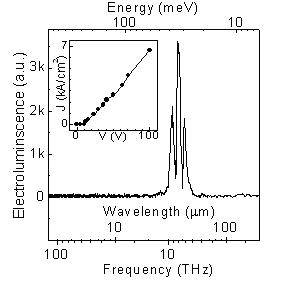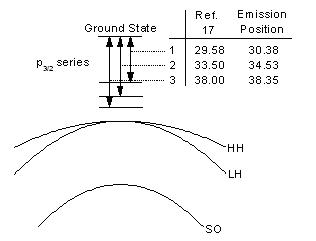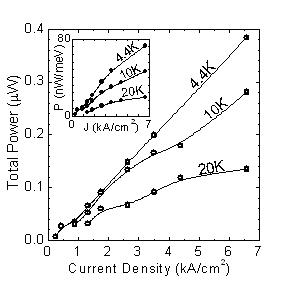Terahertz Electroluminescence from Doped Silicon
Devices
Terahertz Unipolar Emitters
Terahertz emission was observed from electrically pumped boron-doped
p-type silicon structures at cryogenic temperatures. At a peak current
of 1.5 A and a temperature of 4.4 K, we achieved a pulsed peak power
of
31 microWatt from a single mesa facet, integrated over three closely
spaced
spectral lines centered about 8.1 THz; The radiation was slightly
TM-polarized with respect to the plane of the substrate and was still
detectable
at temperatures as high as 150 K; These findings suggest that moderate
power THz sources can be fabricated without epitaxially grown quantum
wells
using techniques compatible with silicon integrated circuit technology.

Spectral power emitted from one mesa facet of the boron-doped silicon
device. The peak current and voltage were 1.5 A and 100 V, respectively,
and the sample temperature was 4.4 K. The maximum spectral power of
the central peak was 384 nW/meV.
The inset depicts the current density versus voltage characteristic.

Figure showing micrograph of THz emitting device and diagram of electrical
pulse biasing.

Schematic depiction of silicon valence bands with acceptor states.
The
inset table shows a comparison of THz emission lines extracted from
peak
positions with acceptor excitation lines published for moderate boron
doping
levels in silicon, in meV. The operating mechanism is by dopant states
that capture carriers from the band, which undergo radiative transitions
and are re- excited by impact ionization.

Dependence of time-averaged total power versus driving current density.
The power was collected from one facet of the mesa device fabricated
from
a 1 p-type boron-doped silicon substrate. The total power
was determined
by integrating the spectral power from 1.5 to 19.5 THz. The inset depicts
the time-averaged spectral power of the central peak at 8.1 THz only
The source was fabricated at the University of Delaware by the Kolodzey
Group (2002, 2003).
End of Test

